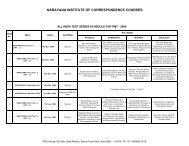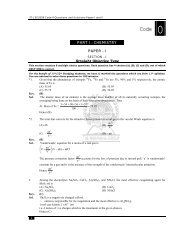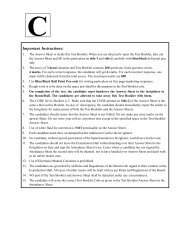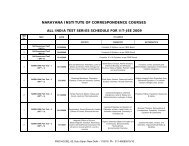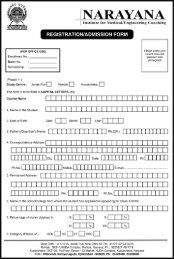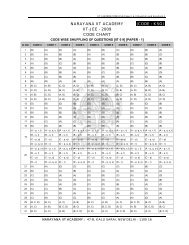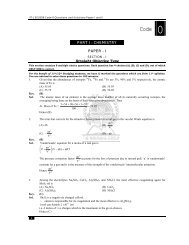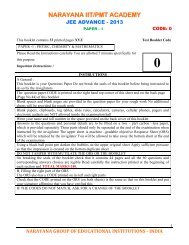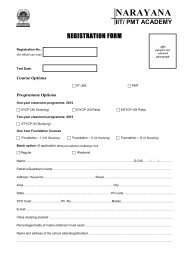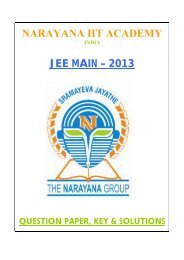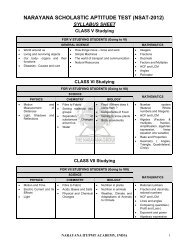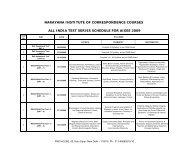NARAYANA IIT/PMT ACADEMY - Narayanaicc.com
NARAYANA IIT/PMT ACADEMY - Narayanaicc.com
NARAYANA IIT/PMT ACADEMY - Narayanaicc.com
You also want an ePaper? Increase the reach of your titles
YUMPU automatically turns print PDFs into web optimized ePapers that Google loves.
<strong>NARAYANA</strong> <strong>IIT</strong>/<strong>PMT</strong> <strong>ACADEMY</strong><br />
JEE ADVANCE : 2013<br />
(PAPER – II) CODE: 0<br />
SECTION – 2 : (Paragraph Type)<br />
This section contains 4 paragraphs each describing theory, experiment, data etc Eight questions relate<br />
to four paragraphs with two questions on each paragraph Each question of a paragraph has only one<br />
correct answer among the four choices (A), (B), (C) and (D)<br />
Paragraph for Questions 29 and 30<br />
An aqueous solution of a mixture of two inorganic salts, when treated with dilute HCl, gave a precipitate<br />
(P) and a filtrate (Q) The precipitate P was found to dissolve in hot water The filtrate (Q) remained<br />
unchanged, when treated with H 2 S in a dilute mineral acid medium However, it gave a precipitate (R)<br />
with H 2 S in an ammoniacal medium The precipitate R gave a coloured solution (S), when treated with<br />
H 2 O 2 in an aqueous NaOH medium<br />
29 The precipitate P contains<br />
(A) Pb 2+<br />
(B)<br />
Ans<br />
Sol<br />
(A)<br />
Salt will be of PbCl 2 as it is soluble in hot water<br />
2<br />
Hg<br />
2<br />
(C) Ag + (D) Hg 2+<br />
30 The coloured solution S contains<br />
(A) Fe 2 (SO 4 ) 3 (B) CuSO 4 (C) ZnSO 4 (D) Na 2 CrO 4<br />
Ans (D)<br />
Sol Cr 3+ + H 2 S/NH 4 OH, NH 4 Cl Cr(OH) 3<br />
Cr(OH) 3 + H 2 O 2 + NaOH Na 2 CrO 4<br />
(yellow colour)<br />
Paragraph for Question 31 and 32<br />
P and Q are isomers of dicarboxylic acid C 4 H 4 O 4 Both decolorize Br 2 / H 2 O On heating, P forms the<br />
cyclic anhydride<br />
Upon treatment with dilute alkaline KMnO 4 , P as well as Q could produce one or more than one from S,<br />
T and U<br />
31 Compounds formed from P and Q are, respectively<br />
(A) Optically active S and optically active pair (T, U)<br />
(B) Optically inactive S and optically inactive pair (T, U)<br />
(C) Optically active pair (T, U) and optically active S<br />
(D) Optically inactive pair (T, U) and optically inactive S<br />
31 (B)<br />
<strong>NARAYANA</strong> GROUP OF EDUCATIONAL INSTITUTIONS - INDIA<br />
17



